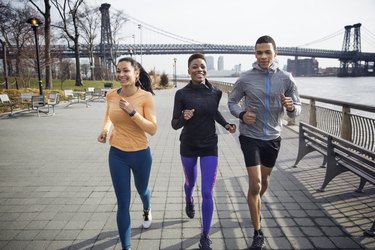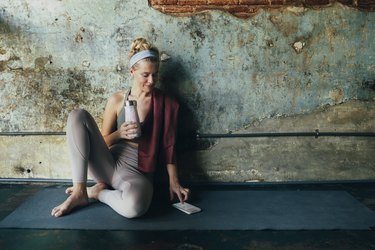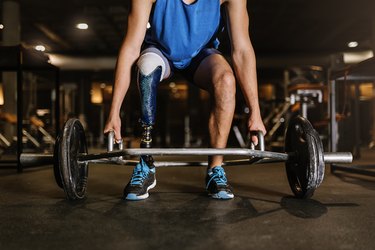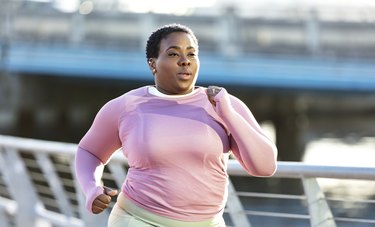

Historically, running communities across the U.S. haven't been as diverse and inclusive as they should be. If you've participated in local races or run clubs in the last decade or so, it doesn't take long to realize that the majority of those who are crossing the finish line are white, skinny and fit.
There's a notion that you have to "look" a certain way, be able to run specific distances and train for competitive races to identify as a runner because that's what history has shown us.
Video of the Day
Video of the Day
Why Running Communities Aren't Diverse
"When you look at the birth of long-distance running, which started in 1963 with Bill Bowerman [founder of Nike and head track and field coach for the 1972 U.S. Olympic Team] in Eugene, Oregon, calling people to run with him, you learn Oregon was a state that forbid Black people from living in it," says Alison Mariella Désir, activist, founder of Harlem Run and Run 4 All Women and author of Running While Black: Finding Freedom in a Sport That Wasn't Built for Us.
"Through my research in my book I learned why. Up until the 1950s, Black people were not allowed to live within the city of Eugene and the state of Oregon in general. So when you think about Bill Bowerman putting his call out for folks to join him for a run, you can look at pictures and see that it was white men, women and children."
As far back as the 1840s, Black exclusion laws were put in place in Oregon that prohibited Black people from living in the state and because of that, there is only a small population of Black and brown people living there today, according to the Oregon Historical Society.
The U.S.'s deeply racist history, such as the exclusion laws in Oregon, is one of the many reasons why Black and brown runners are still largely underrepresented in the sport today, Désir says.
Leadership in running, such as board members at organizations or those who are putting together race events, has also been largely centered on white people — particularly white men, Désir says. It doesn't help that running organizations, athletic brands and media outlets have failed to adequately highlight runners of color and create a safe running space for marginalized folks.
"The power has been concentrated in white hands, and they've also been the ones responsible for the representation of who a runner is. All of that factors into why Black and brown people have never really received the message that [running] was for them," Désir explains.
So, if you're looking to create meaningful change within your own running community and transform it into a group that truly represents the people you want to join your club, it requires a hard look at factors like leadership boards and neighborhoods where you host your runs.
Ahead, we spoke to run club leaders and activists to share steps you can take to make your community more inclusive.
1. Evaluate Your Run Club's Leadership Board
The people at the top of the running pack are indicative of how diverse a running group is, so you have to look at who's shepherding your run club's efforts. If everyone on your leadership board looks just like you, is of the same background or is similar in age and body type, that's a sign your run club can do more to diversify its team.
"It starts with the leaders of the running club! Who do they represent, what do they look like, how do they interact with the community and how are they welcoming new runners?" says Sid Baptista, founder of the PIONEERS Run Crew — the first Black- and brown-led running group in Boston — and PYNRS, a performance streetwear brand.
If you're a leader in a running group, you can also foster inclusivity by encouraging others who might have never seen themselves as a leader. There may be people in your club who have all the skills and qualities of a leader, but they don't realize that they are able to step into that role, so it's helpful to create opportunities for cultivating new leaders, Désir says.
"I've been mindful whenever I'm looking at leaders, to pursue people who are racially diverse and who are of different backgrounds, ages and body types. Because a leader is somebody who the community looks up to and says, 'Oh, they represent me in some way.' The more diverse leadership you have, the more the community will feel represented and, in turn, show up," she says.
2. Vary the Neighborhoods Where You Host Your Runs
You can expand the reach of your running community by hosting weekly runs in different neighborhoods in your town or city. This allows people in marginalized communities to feel like they're welcome and can participate.
"Don't say you want to be an inclusive running group, but then only host runs in your homogenous areas. Be willing to either give rides to people or take the time to drive somewhere else that can be more accessible," says Carolyn Su, founder of Diverse We Run, an Instagram account that spotlights racially diverse runners in the U.S. and abroad. "There is a cost to diversity and inclusion, and that cost is most often the discomfort of having to make effort or sacrifice time."
Take the time and effort to connect with runners from the neighborhoods you're looking to reach and help them lead through resources and support, according to Baptista.
"Don't expect people to leave their neighborhoods to come to you to train. Go find them in their neighborhood, but do it in an authentic way," he says.
This may mean you collaborate with other local running groups of different demographics and work with them to host weekly community runs and events. When people see you've worked with groups they identify with, that can make them feel more inclined to participate.
"It's really dependent on the people who have the power and the privilege to take the steps to give of themselves," says Mikah Meyer, an LGBTQ+ activist and Brooks Running Run Happy advocate.
For example, "cities now have an intersection that has a rainbow sidewalk, and you could say, 'Hey, this month for our outreach run, we're going to meet at an intersection that has the rainbow sidewalk and reach out to the queer community.' I think if they made it about going into spaces where the people with the power and privilege feel uncomfortable, then that means the people who don't have that are more comfortable and more likely to attend."
"If you're supporting a charity, go volunteer for that charity. Go find someone in that community and support their running journey. Just as it takes time and practice to run a marathon, it takes time and effort to make a difference."
3. Make Sure Your Runs Are Truly for Everyone
One barrier many people may come up against when joining a new run community is they are often focused on hitting certain paces and training for particular competitive races, but not everyone has their eye on a medal or is collecting race bibs. Running can mean different things for people, so consider adding a walking group or a run-walking group.
"If you're looking to engage new communities that haven't found their place, having walking and run-walking groups is a great way to invite new runners in. Just make sure you're not making it seem like, 'Oh, this is the baby version of the workout and one day you'll get to do this other version,'" Désir says.
It also helps to be up front that people of all levels are welcome to join your runs.
"People get intimidated if they've never met with a club before, but making sure highlight that all levels are welcome is really important," says Grace Zamudio, co-founder of Angel City Elite, a Los Angeles-based run club seeking to increase BIPOC representation in the running community.
Slow AF Run Club, founded by Martinus Evans, is a running group that lives by these ideals. According to the club's website, Evans created the Slow AF Run Club "to be the world's largest inclusive online community for back-of-the-pack runners." Its main mission: "To empower every person on this planet to become a runner in the body they have right now."
4. Get to Know New Members
If a new person joins your run, make sure to introduce yourself and take time to get to know them. Welcoming new runners into your group is a great step toward making connections with those in communities you're trying to reach.
"I travel about 75 percent of the year, so I often will look up the local queer running club and join that because I know it's a great way to meet people and it's a space where I know my queerness is celebrated. The best examples are those that at the beginning of every run, they introduce themselves, [say] their pronouns and mention the distance and time. And they make a point of saying where they're meeting afterward so you can join them," Meyer says.
This way, there's no pressure to cover a certain distance or finish at a certain time, and you can meet people after your run.
In addition to making new members feel welcome, you can also share resources to support others in their running journey. Sharing your knowledge of training and races with other runners can make them feel like you're invested in them, says Sabrina De La Cruz, co-founder of Angel Elite City.
Keep in mind that new runners might not always know running lingo, so it's also helpful to break down the day's workout in a way that's easy to understand.
"Use inclusive language and common, non-runner terms so as not to scare people away. Refrain from talking about specific paces and say something like, '60 percent effort' or 'a pace that you can hold for a 30-minute run,'" Baptista says. "For example, when talking about a track workout that includes a 400-meter and 800-meter rep, say, 'We're doing 400 meters, and that is one lap, followed by 800 meters, which is two laps.'"
5. Build Meaningful Connections Outside of Running
Running isn't always about achieving personal records and crossing finish lines. For most people, connection is the heart of running clubs. So if you're reaching out to communities, where you're fundraising or raising awareness for certain social causes and charities, make it a point to truly listen and serve that community's needs.
Although financial contributions are important, connecting with the people leading these organizations and charities can help you build a more authentic relationship with them.
"It's easy to give money to a charity and say you support a community or social cause. But it makes a difference to show up in the communities that are affected by the said issues. Don't just talk about it, be about it," Baptista says. "If you're supporting a charity, go volunteer for that charity. Go find someone in that community and support their running journey. Just as it takes time and practice to run a marathon, it takes time and effort to make a difference."
You can also build upon your running group's charity and social justice efforts by bringing in leaders from that community to help tailor what fundraising and support should look like, Désir says.
6. Celebrate All Types of Runners in Your Group
Being inclusive means highlighting runners of different backgrounds, running abilities and body types. It's common to celebrate and acknowledge only elite runners, or those who are fast and run competitive races, but it can make other runners feel like they don't "fit" into the group or have a place.
"Celebrate consistency over speed and time. Award improvement and effort and not just pace. Team leaders should celebrate the energy, support and excitement that a runner brings to the team just as much, if not more, as how fast someone is," Baptista says.
The people you spotlight on your run club's social media and marketing also plays a role in the message you're sending to others about how inclusive and diverse you'd like your club to be.
"The bodies, the people, the faces that you're featuring and using for your different events makes a difference in conveying the culture and values of the group," Su says.
So much of what we see being celebrated on social media are people who are at the top of their game. But the average runner? We don't see them enough, so by carving out space for the everyday runner, you can make your club a more welcoming place.
"We see so much of highlighting elite athletes and people who win marathons or those who are the most physically fit. The reality is that 99.99 percent of us runners will never attain that level. The more we can remember that most of us aren't the Michael Jordan of the sport, the more people will be involved in the sport and the more people will feel like they can bring their full selves to the sport," Meyer says.
If your run club also sells gear, it's important to make sure that it caters to people of all different types of body shapes and sizes and that you're using models who are racially diverse.
"There is power in representation. It's not like you're trying to idolize people, but it awakens curiosity in others and makes them think, 'Well, what could I do? What could I be? Could it be possible for me?,'" Su says.
"Celebrate consistency over speed and time. Award improvement and effort and not just pace. Team leaders should celebrate the energy, support and excitement that a runner brings to the team just as much, if not more, as how fast someone is."
7. Be Civically Engaged
When you're looking to diversify your running community, you're going to come up against a history of racism and the current political climate. It's one of the main reasons why it's difficult to make a racially inclusive running space, and that's why it's important to be politically engaged.
"It's your local politicians that are determining what their zoning laws are. It's not by accident that white people live in one place, Black people live in another place and Asian people live here. There were laws and there continue to be policies, whether it's housing or zoning, that intentionally segregate people into communities," Désir says. "So the more you can start to think about these things, the more civically engaged a person you can be."


